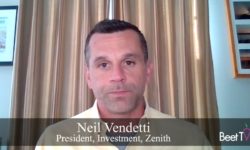In a challenging business environment and with traditional TV viewing waning, a growing number of brands and their ad agencies are leaning into connected TV.
There, they can employ data-driven buying, targeting and measurement. But what’s the right balance of digital and linear, and how can buyers wring the best effect from the new channel?
That is what seven executives discussed during Optimizing a Rapidly Converging TV & Video Marketplace: What’s Next, a recently-wrapped Beet.TV leadership series presented by Amobee. Here are the highlights.
1. Chasing ad evidence
Neil Vendetti, president of US investment at Publicis Groupe’s Zenith, says proving the reach of non-linear ads is difficult.
“It’s a good problem for us to have as an industry that we are pushing, almost in every case, in advance of our ability to prove some of these things out.”
Upfront Ad Buying Going Digital – And Siloed, Zenith’s Vendetti Says
2. This is the year for streaming TV
Tubi chief revenue officer Mark Rotblat is counting booming new ad revenue for his OTT TV company, owned by Fox – and he is expecting more.
“What we’re hearing in the market from our advertising partners, that there’s going to be a big shift. (Omnicom’s) chief investment officer was saying this is the year.”
Audience Shift to Streaming Makes for Record-Setting Year: Tubi’s Mark Rotblat
3. Mars aims to stay flexible
A perfect storm of media consumption shifts and new business pressures is prompting Mars toward more agile and digital TV options, says senior global media director Ron Amram
“More consumption is pivoting away from traditional television. TV is becoming a less specifically upfront investment, becoming a smaller share of our spend and, in the world of COVID, we do need a bit more flexibility.
Upfront Market Faces Pressure Amid Need for Flexibility: Mars’ Ron Amram
4. Connected TV can augment linear ads
JPMorgan Chase’s chief media officer Tracy-Ann Lim says the finance giant has “a great playbook in the works” for deploying advanced video advertising.
“With more streaming options available and with people spending more time with video … we see this as a great opportunity to lean on sight, sound and motion to tell our story, but do it in a way that we’re able to go far beyond the usual age (and) sex demo(graphics).”
5. Agencies going beyond demographics
Vinny Rinaldi, head of activation and audience at GroupM’s Wavemaker, says it is important for advertisers to build a data infrastructure to match the new opportunities.
“Your data infrastructure is so important to thinking through what it is from a planning perspective, a buying perspective and an outcomes perspective. I think we’ve got to hone in and really create a structure with technology as that layer that informs our media ecosystem.”
With Tech In Tow, TV Upfronts Still Matter: Wavemaker’s Rinaldi
6. Optimization outperforms measurement
In an environment of business pressure, marketing optimization can be more effective than measurement, says Dan Aversano, senior vice president of data, analytics and advanced advertising at Spanish-language broadcaster Univision
“A lot of people spend a lot of time talking about measurement and particularly across platform measurement, how we can look in the rear view mirror and tell you what happened yesterday. Optimization lets you look forward, predict what’s going to happen tomorrow and then fundamentally make better decisions.”
Optimization Lets Marketers Look Forward With Ad Spend: Univision’s Dan Aversano
7. Upfronts and programmatic will co-exist
TV won’t go wholly programmatic, according to Peter Olsen, executive vice president of ad sales and content partnerships at A+E Networks.
“The human element will always be a part of it. I believe the upfront, as we know, will exist well past our lifetimes. But we can borrow lessons from programmatic and programmatic can borrow lessons from traditional.”
Brands, DTC Marketers All Benefit From TV Ads: A+E’s Peter Olsen










































